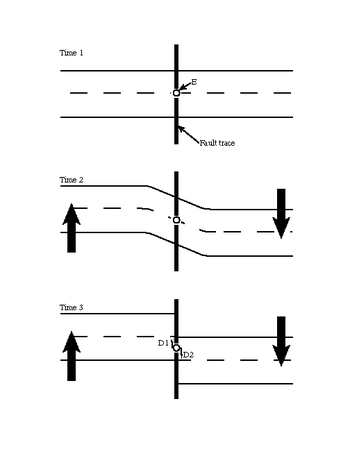
Elastic-rebound theory
Encyclopedia

In geology
Geology
Geology is the science comprising the study of solid Earth, the rocks of which it is composed, and the processes by which it evolves. Geology gives insight into the history of the Earth, as it provides the primary evidence for plate tectonics, the evolutionary history of life, and past climates...
, the elastic rebound theory was the first theory
Theory
The English word theory was derived from a technical term in Ancient Greek philosophy. The word theoria, , meant "a looking at, viewing, beholding", and referring to contemplation or speculation, as opposed to action...
to satisfactorily explain earthquake
Earthquake
An earthquake is the result of a sudden release of energy in the Earth's crust that creates seismic waves. The seismicity, seismism or seismic activity of an area refers to the frequency, type and size of earthquakes experienced over a period of time...
s. Previously it was thought that ruptures of the surface were the result of strong ground shaking rather than the converse suggested by this theory.
Ancient cultural explanations of earthquakes were often along the lines of the mythical Japanese Namazu
Namazu
In Japanese mythology, the Namazu or Ōnamazu is a giant catfish who causes earthquakes. He lives in the mud beneath the earth, and is guarded by the god Kashima who restrains the catfish with a stone. When Kashima lets his guard fall, Namazu thrashes about, causing violent earthquakes...
: A giant catfish with the islands of Japan on his back. A demigod, or daimyojin, holds a heavy stone over his head to keep him from moving. Once in a while the daimyojin is distracted so Namazu moves and the Earth trembles.
The theory explained
Following the great 1906 San Francisco earthquake1906 San Francisco earthquake
The San Francisco earthquake of 1906 was a major earthquake that struck San Francisco, California, and the coast of Northern California at 5:12 a.m. on Wednesday, April 18, 1906. The most widely accepted estimate for the magnitude of the earthquake is a moment magnitude of 7.9; however, other...
, Harry Fielding Reid
Harry Fielding Reid
Harry Fielding Reid was an American geophysicist. He was notable for his contributions to seismology, particularly his theory of elastic rebound that related faults to earthquakes....
examined the displacement of the ground surface around the San Andreas Fault
San Andreas Fault
The San Andreas Fault is a continental strike-slip fault that runs a length of roughly through California in the United States. The fault's motion is right-lateral strike-slip...
. From his observations he concluded that the earthquake
Earthquake
An earthquake is the result of a sudden release of energy in the Earth's crust that creates seismic waves. The seismicity, seismism or seismic activity of an area refers to the frequency, type and size of earthquakes experienced over a period of time...
must have been the result of the elastic rebound of previously stored elastic strain
Strain (materials science)
In continuum mechanics, the infinitesimal strain theory, sometimes called small deformation theory, small displacement theory, or small displacement-gradient theory, deals with infinitesimal deformations of a continuum body...
energy in the rocks on either side of the fault. In an interseismic period, the Earth's plates (see plate tectonics
Plate tectonics
Plate tectonics is a scientific theory that describes the large scale motions of Earth's lithosphere...
) move relative to each other except at most plate boundaries where they are locked. Thus, if a road is built across the fault as in the figure panel Time 1, it is perpendicular to the fault trace at the point E, where the fault is locked. The far field plate motions (large arrows) cause the rocks in the region of the locked fault to accrue elastic deformation, figure panel Time 2. The deformation builds at the rate of a few centimeters per year, over a time period of many years. When the accumulated strain
Strain (materials science)
In continuum mechanics, the infinitesimal strain theory, sometimes called small deformation theory, small displacement theory, or small displacement-gradient theory, deals with infinitesimal deformations of a continuum body...
is great enough to overcome the strength of the rocks, an earthquake occurs. During the earthquake, the portions of the rock around the fault that were locked and had not moved 'spring' back, relieving the displacement in a few seconds that the plates moved over the entire interseismic period (D1 and D2 in Time 3). The time period between Time 1 and Time 2 could be months to hundreds of years, while the change from Time 2 to Time 3 is seconds. Like an elastic band, the more the rocks are strained the more elastic energy is stored and the greater potential for an event. The stored energy is released during the rupture partly as heat, partly in damaging the rock, and partly as elastic waves. Modern measurements using GPS
Global Positioning System
The Global Positioning System is a space-based global navigation satellite system that provides location and time information in all weather, anywhere on or near the Earth, where there is an unobstructed line of sight to four or more GPS satellites...
largely support Reid’s theory as the basis of seismic movement, though actual events are often more complicated.

